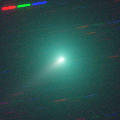
|
Brightening very rapidly. Now it is very bright as 7.6 mag (Mar. 25, Maik Meyer). It moves along the same orbit as C/1844 Y1 (Great Comet). It approaches to Sun down to 0.25 a.u. on May 31. It is expected to brighten up to -1 mag. In the Northern Hemisphere, it stays observable in excellent condition until mid May when it brightens up to 1-2 mag. In the Southern Hemisphere, it is not observable until June.
Date(TT) R.A. (2000) Decl. Delta r Elong. m1 Best Time(A, h)
Mar. 28 8 24.01 68 30.8 1.059 1.547 97 7.5 19:57 (180,-13)
Apr. 4 7 33.31 68 17.0 1.035 1.419 88 7.1 19:14 (177,-13)
|

|
Now it is 8.5 mag (Mar. 25, Maik Meyer). It stays bright as 8-9 mag until July. It is observable in good condition in the Northern Hemisphere. In the Southern Hemisphere, it is not observable until July.
Date(TT) R.A. (2000) Decl. Delta r Elong. m1 Best Time(A, h)
Mar. 28 2 50.09 67 37.4 1.771 1.694 69 8.4 19:23 (156,-26)
Apr. 4 3 11.74 69 41.2 1.764 1.668 67 8.3 19:14 (158,-27)
|
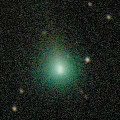
|
Now it is very bright as 8.2 mag (Mar. 25, Maik Meyer). It stays bright as 8-9 mag until mid April. In the Northern Hemisphere, it stays observable for a long time, although it becomes extremely low in March. In the Southern Hemisphere, it is not observable until June when it fades down to 15 mag. It seems to be a fragment of C/1988 A1 (Liller), like C/1996 Q1 (Tabur) and C/2015 F3 (SWAN).
Date(TT) R.A. (2000) Decl. Delta r Elong. m1 Best Time(A, h)
Mar. 28 0 14.05 42 37.0 1.358 0.869 39 8.6 4:45 (238,-34)
Apr. 4 0 22.08 50 5.8 1.287 0.913 44 9.0 4:51 (228,-32)
|

|
It has not been observed yet in this apparition. The condition of this apparition is bad, and it it not observable before the perihelion passage. It will appear in the morning sky at 12 mag in mid April in the Northern Hemisphere, or at 15 mag in mid May in the Southern Hemisphere. However, it will fade out rapidly, and will be fainter than 18 mag in June.
Date(TT) R.A. (2000) Decl. Delta r Elong. m1 Best Time(A, h)
Mar. 28 1 21.39 5 19.7 1.497 0.577 13 12.7 19:23 ( 91, -8)
Apr. 4 2 1.92 10 28.1 1.393 0.535 17 12.0 19:14 ( 99, -6)
|

|
Now it is 13.2 mag (Mar. 9, Thomas Lehmann). It stays bright as 12-13 mag until summer. But it becomes low in spring. In the Southern Hemisphere, it will never be observable again.
Date(TT) R.A. (2000) Decl. Delta r Elong. m1 Best Time(A, h)
Mar. 28 0 22.94 52 41.5 3.956 3.397 49 12.7 4:45 (227,-38)
Apr. 4 0 30.68 54 26.2 3.996 3.424 48 12.8 4:51 (224,-35)
|
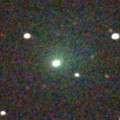
|
Now it is very bright as 12.0 mag (Mar. 26, Michael Mattiazzo). It will approach to Sun down to 0.9 a.u. in June, and it is extected to brighten up to 8.5 mag. In the Southern Hemisphere, it stays observable in good condition for a long time after this. In the Northern Hemisphere, it will be unobservable from late March to late June.
Date(TT) R.A. (2000) Decl. Delta r Elong. m1 Best Time(A, h)
Mar. 28 4 13.67 -23 55.3 1.895 1.662 61 13.3 19:23 ( 89, 43)
Apr. 4 4 22.09 -23 29.5 1.841 1.574 58 13.0 19:14 ( 88, 41)
|
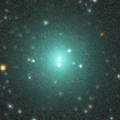
|
It brightened up to 10.2 mag in February (Feb. 6, Maik Meyer). Now it is fading rapidly. It has already faded down to 13.4 mag (Mar. 15, Sandor Szabo). It is observable in good condition in the Northern Hemisphere. In the Southern Hemisphere, it is only visible in the extremely low sky in spring.
Date(TT) R.A. (2000) Decl. Delta r Elong. m1 Best Time(A, h)
Mar. 28 5 18.23 53 17.8 1.530 1.633 77 13.1 19:23 (159, -4)
Apr. 4 5 33.93 48 25.9 1.726 1.718 72 13.5 19:14 (156, 0)
|

|
Now it is not observable. It will appear in the morning sky in June.
Date(TT) R.A. (2000) Decl. Delta r Elong. m1 Best Time(A, h)
Mar. 28 1 20.62 16 55.1 6.729 5.795 19 13.9 19:23 (100,-15)
Apr. 4 1 26.15 17 26.0 6.760 5.796 14 13.9 19:14 ( 99,-18)
|
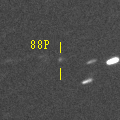
|
Now it is 15.4 mag (Mar. 20, Chris Wyatt). Brightening very rapidly. It will brighten up to 8-9 mag from summer to autumn. It will be observable in excellent condition in the Southern Hemisphere. It locates very low around the high light in the Northern Hemisphere.
Date(TT) R.A. (2000) Decl. Delta r Elong. m1 Best Time(A, h)
Mar. 28 13 32.10 -4 13.7 1.286 2.262 163 14.6 1:11 (180, 59)
Apr. 4 13 25.88 -3 40.3 1.221 2.216 171 14.2 0:37 (180, 59)
|
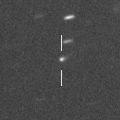
|
Now it is 14.7 mag (Mar. 15, Sandor Szabo). It stays 13-14 mag from 2020 to 2021. It stays observable in good condition for a while.
Date(TT) R.A. (2000) Decl. Delta r Elong. m1 Best Time(A, h)
Mar. 28 12 59.86 17 1.3 2.389 3.337 158 14.3 0:38 (180, 38)
Apr. 4 12 54.87 17 23.3 2.377 3.321 156 14.3 0:06 (180, 38)
|
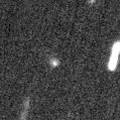
|
Now it is 14.4 mag (Mar. 15, Sandor Szabo). It will brighten up to 10.5 mag from 2020 December to 2021 January. In the Northern Hemisphere, it stays observable in good condition while the comet will be brightening gradually, but it is not observable at the high light. In the Southern Hemisphere, it is not observable for a long time, but it will be observable in good condition after the high light.
Date(TT) R.A. (2000) Decl. Delta r Elong. m1 Best Time(A, h)
Mar. 28 18 34.37 72 56.2 3.366 3.454 86 14.5 4:45 (187,-19)
Apr. 4 18 21.89 74 53.0 3.299 3.389 86 14.4 4:51 (183,-20)
|
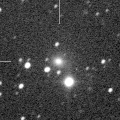
|
Now it is bright as 14.0 mag (Mar. 19, Chris Wyatt). It stays 14 mag until spring. It stays observable for a long time in the Southern Hemisphere. It is not observable until August in the Northern Hemisphere.
Date(TT) R.A. (2000) Decl. Delta r Elong. m1 Best Time(A, h)
Mar. 28 2 0.31 -49 33.7 4.058 3.600 56 14.5 19:23 ( 47, 28)
Apr. 4 2 8.21 -47 35.4 4.086 3.620 55 14.6 19:14 ( 49, 25)
|

|
Now it is 15.8 mag (Mar. 18, Toshihiko Ikemura, Hirohisa Sato). It will brighten up to 13 mag in 2021. In 2020, it is observable at 15 mag in good condition from spring to summer.
Date(TT) R.A. (2000) Decl. Delta r Elong. m1 Best Time(A, h)
Mar. 28 14 53.87 -18 9.6 4.521 5.335 141 15.5 2:32 (180, 73)
Apr. 4 14 50.09 -18 34.7 4.412 5.293 148 15.5 2:01 (180, 74)
|
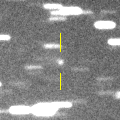
|
First return of a new periodic comet discovered in 2006. It brightened up to 14.9 mag in January (Jan. 21, R. Fichtl). It will never be observable after this.
Date(TT) R.A. (2000) Decl. Delta r Elong. m1 Best Time(A, h)
Mar. 28 1 26.11 -1 27.1 2.643 1.701 15 15.6 19:23 ( 86, -4)
Apr. 4 1 45.67 0 1.9 2.657 1.706 14 15.6 19:14 ( 87, -4)
|

|
Now it is 15.6 mag (Mar. 20, Toshihiko Ikemura, Hirohisa Sato). It is expected to be observable at 5-6 mag for a long time from 2022 to 2023. In the Northern Hemisphere, it is not observable at the high light from 2022 summer to 2023 summer. In the Southern Hemisphere, it is only visible in the extremely low sky in summer in 2020. But it will be observable in good condition at the high light.
Date(TT) R.A. (2000) Decl. Delta r Elong. m1 Best Time(A, h)
Mar. 28 18 19.17 49 30.9 9.473 9.510 89 15.7 4:45 (191, 4)
Apr. 4 18 18.85 50 4.2 9.388 9.460 91 15.6 4:51 (186, 5)
|

|
Now it is 16.0 mag (Dec. 4, Kunihiro Shima). It stays 15-16 mag for a long time until 2021.
Date(TT) R.A. (2000) Decl. Delta r Elong. m1 Best Time(A, h)
Mar. 28 20 53.09 -3 31.6 5.038 4.523 53 16.1 4:45 (252, 29)
Apr. 4 20 54.22 -2 13.4 4.929 4.515 60 16.0 4:51 (245, 34)
|

|
Now it is 14.6 mag (Dec. 28, Chris Wyatt). It will be fading slowly after this. In the Southern Hemisphere, it becomes low from February to March, but it stays observable for a long time. In the Northern Hemisphere, it is not observasble until June.
Date(TT) R.A. (2000) Decl. Delta r Elong. m1 Best Time(A, h)
Mar. 28 23 39.88 -37 0.9 4.440 3.752 41 16.1 4:45 (305, 15)
Apr. 4 23 45.20 -35 54.9 4.433 3.786 44 16.1 4:51 (301, 19)
|

|
It brightened up to 7.7 mag in June in 2018 (June 19, Juan Jose Gonzalez). Now it is fading. It has already faded down to 16.4 mag (Mar. 20, Toshihiko Ikemura, Hirohisa Sato). In the Southern Hemisphere, it stays observable for a long time until the comet will fade out. In the Northern Hemisphere, it stays low for a while.
Date(TT) R.A. (2000) Decl. Delta r Elong. m1 Best Time(A, h)
Mar. 28 5 32.32 -18 23.4 6.443 6.310 77 16.2 19:23 (110, 56)
Apr. 4 5 33.94 -17 22.2 6.584 6.364 73 16.3 19:14 (108, 52)
|

|
Now it is 16.4 mag (Feb. 28, iTelescope Observatory, Siding Spring). It started getting fainter before the perihelion passage. It seems to be fainter than 18 mag in June. In the Southern Hemisphere, it will be too low to observe soon. It is not observable in the Northern Hemisphere.
Date(TT) R.A. (2000) Decl. Delta r Elong. m1 Best Time(A, h)
Mar. 28 3 13.38 -39 30.6 2.449 2.082 57 16.4 19:23 ( 64, 37)
Apr. 4 3 27.68 -35 15.8 2.517 2.105 54 16.5 19:14 ( 68, 34)
|
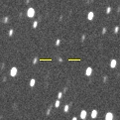
|
Now it is 17.2 mag (Mar. 20, Toshihiko Ikemura, Hirohisa Sato). It will stay at 14 mag for a long time from 2021 to 2022. In the Northern Hemisphere, it stays observable in good condition while brightening gradually. In the Southern Hemisphere, it is appearing in the morning sky. But it stays locating low for a long time.
Date(TT) R.A. (2000) Decl. Delta r Elong. m1 Best Time(A, h)
Mar. 28 19 15.86 31 32.5 6.775 6.642 78 16.5 4:45 (208, 17)
Apr. 4 19 15.47 31 57.6 6.669 6.609 82 16.4 4:51 (201, 19)
|
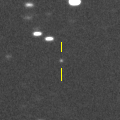
|
Now it is 16.1 mag (Mar. 18, Toshihiko Ikemura, Hirohisa Sato). It stays observable at 16 mag in good condition until April.
Date(TT) R.A. (2000) Decl. Delta r Elong. m1 Best Time(A, h)
Mar. 28 10 11.93 26 23.3 0.803 1.672 136 16.4 21:46 (180, 29)
Apr. 4 10 4.75 22 2.5 0.829 1.662 130 16.5 21:12 (180, 33)
|

|
Now it is 16.1 mag (Mar. 18, Toshihiko Ikemura, Hirohisa Sato). It stays observable at 16-17 mag from 2020 to 2021. It locates somewhat low in the Northern Hemisphere.
Date(TT) R.A. (2000) Decl. Delta r Elong. m1 Best Time(A, h)
Mar. 28 10 43.66 -22 27.0 5.717 6.586 148 16.5 22:18 (180, 78)
Apr. 4 10 42.36 -21 47.5 5.744 6.585 144 16.5 21:50 (180, 77)
|

|
It brightened up to 12-13 mag from 2018 to 2019. Now it is fading. It has already faded down to 16.5 mag (Mar. 8, J. Drummond). In the Southern Hemisphere, it stays observable in good condition for a long time. It will never be observable after this in the Northern Hemisphere.
Date(TT) R.A. (2000) Decl. Delta r Elong. m1 Best Time(A, h)
Mar. 28 11 2.50 -76 4.4 4.755 5.120 105 16.5 22:34 ( 0, 49)
Apr. 4 10 32.97 -75 11.0 4.773 5.166 107 16.5 21:38 ( 0, 50)
|
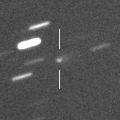
|
Now it is 16.7 mag (Feb. 27, Toshihiko Ikemura, Hirohisa Sato). It brightens up to 16.5 mag and will be observable in good condition from March to April.
Date(TT) R.A. (2000) Decl. Delta r Elong. m1 Best Time(A, h)
Mar. 28 13 24.78 -0 1.0 1.183 2.164 165 16.5 1:03 (180, 55)
Apr. 4 13 20.19 0 20.0 1.180 2.174 170 16.5 0:31 (180, 55)
|
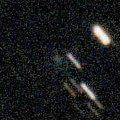
|
Now it is 16.9 mag (Mar. 18, Toshihiko Ikemura, Hirohisa Sato). It stays 16.5 mag until late March. It is not observable in the Southern Hemisphere.
Date(TT) R.A. (2000) Decl. Delta r Elong. m1 Best Time(A, h)
Mar. 28 3 10.39 33 16.6 2.008 1.542 48 16.6 19:23 (129, -4)
Apr. 4 3 34.52 35 16.4 2.062 1.569 47 16.8 19:14 (131, -4)
|

|
Now it is 15.8 mag (Mar. 1, iTelescope Observatory, Siding Spring). It is observable at 16.5 mag in 2020. It is observable in excellent condition in the Southern Hemisphere. It locates somewhat low in the Northern Hemisphere.
Date(TT) R.A. (2000) Decl. Delta r Elong. m1 Best Time(A, h)
Mar. 28 20 11.01 -30 9.9 6.840 6.557 69 16.7 4:45 (276, 51)
Apr. 4 20 10.20 -30 2.9 6.730 6.567 76 16.7 4:51 (272, 58)
|
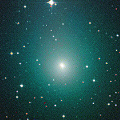
|
It brightened up to 8.3 mag in September (Sept. 20, Maik Meyer). Now it is fading. It has already faded down to 14.9 mag (Dec. 28, Chris Wyatt). In the Southern Hemisphere, it stays observable for a long time after this. In the Northern Hemisphere, it will never be observable again.
Date(TT) R.A. (2000) Decl. Delta r Elong. m1 Best Time(A, h)
Mar. 28 23 59.15 -53 33.4 3.459 3.031 56 16.7 4:45 (322, 21)
Apr. 4 0 10.93 -54 44.1 3.459 3.101 61 16.8 4:51 (321, 24)
|

|
It brightened up to 13.8 mag in 2019 winter (Dec. 21, Thomas Lehmann). Now it is fading. It has already faded down to 17.2 mag (Mar. 18, Toshihiko Ikemura, Hirohisa Sato). It will be fainter than 18 mag in May. In the Northern Hemisphere, it is observable in excellent condition. It locates low in the Southern Hemisphere.
Date(TT) R.A. (2000) Decl. Delta r Elong. m1 Best Time(A, h)
Mar. 28 5 59.98 11 42.3 1.564 1.745 82 16.8 19:23 (147, 37)
Apr. 4 6 16.76 11 6.4 1.649 1.775 80 17.1 19:14 (146, 37)
|
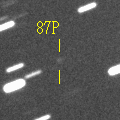
|
Now it is 16.3 mag (Mar. 20, Toshihiko Ikemura, Hirohisa Sato). It will brighten up to 17 mag and will be observable in excellent condition from March to May.
Date(TT) R.A. (2000) Decl. Delta r Elong. m1 Best Time(A, h)
Mar. 28 12 51.47 -4 41.5 1.128 2.123 173 17.0 0:30 (180, 60)
Apr. 4 12 47.44 -4 1.3 1.116 2.116 177 17.0 23:54 (180, 59)
|

|
Now it is 18.3 mag (Mar. 18, Catalina Sky Survey). It will brighten rapidly, and will brighten up to 9.5 mag in June. It is not observable in June. However, it stays observable in good condition until May while the comet is brightening, and after July while the comet will be fading.
Date(TT) R.A. (2000) Decl. Delta r Elong. m1 Best Time(A, h)
Mar. 28 11 0.89 -12 13.9 0.710 1.674 156 17.2 22:34 (180, 67)
Apr. 4 10 40.50 -10 8.9 0.652 1.587 146 17.1 21:46 (180, 65)
|
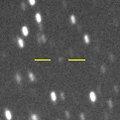
|
Now it is 17.4 mag (Feb. 23, Toshihiko Ikemura, Hirohisa Sato). It is expected to brighten up to 13 mag in 2022. In 2020, it is observable in excellent condition in the Southern Hemisphere. In the Northern Hemisphere, it will be unobservable soon. It will be observable again from autumn to winter, but it locating extremely low.
Date(TT) R.A. (2000) Decl. Delta r Elong. m1 Best Time(A, h)
Mar. 28 6 10.79 -30 28.6 7.534 7.563 87 17.2 19:23 ( 96, 69)
Apr. 4 6 12.70 -29 49.9 7.558 7.522 84 17.2 19:14 ( 94, 66)
|

|
Now it is 17.6 mag (Feb. 3, ATLAS-HKO, Haleakala). It brightened up to 14 mag from autumn to winter in 2018. Now it is fading. It is observable at 17.5 mag in good condition from winter to spring.
Date(TT) R.A. (2000) Decl. Delta r Elong. m1 Best Time(A, h)
Mar. 28 13 20.48 -3 9.9 3.682 4.660 166 17.3 0:59 (180, 58)
Apr. 4 13 14.82 -3 6.0 3.703 4.699 173 17.2 0:26 (180, 58)
|

|
It will brighten up to 15.5 mag and will be observable in good condition from June to September.
Date(TT) R.A. (2000) Decl. Delta r Elong. m1 Best Time(A, h)
Mar. 28 19 21.73 -4 33.4 2.509 2.478 76 17.3 4:45 (233, 47)
Apr. 4 19 31.76 -3 14.6 2.408 2.454 80 17.2 4:51 (225, 49)
|

|
Now it is 18.3 mag (Mar. 22, Toshihiko Ikemura, Hirohisa Sato). It will be fading slowly after this. It is observable in good condition in the Northern Hemisphere. In the Southern Hemisphere, it is observable in the extremely low sky only in 2021 spring.
Date(TT) R.A. (2000) Decl. Delta r Elong. m1 Best Time(A, h)
Mar. 28 13 7.56 56 7.5 8.215 8.761 120 17.2 0:46 (180, -1)
Apr. 4 13 3.24 56 0.5 8.254 8.772 118 17.3 0:14 (180, -1)
|
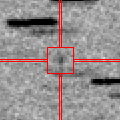
|
Now it is 17.6 mag (Mar. 22, Toshihiko Ikemura, Hirohisa Sato). It will brighten up to 15.5 mag from June to August, and it will be observable in good condition.
Date(TT) R.A. (2000) Decl. Delta r Elong. m1 Best Time(A, h)
Mar. 28 18 22.95 -10 41.5 2.053 2.309 91 17.5 4:45 (220, 60)
Apr. 4 18 33.07 -9 54.8 1.953 2.283 95 17.3 4:51 (209, 62)
|

|
Now it is 17.5 mag (Mar. 20, Toshihiko Ikemura, Hirohisa Sato). It will be observable at 16.5-17 mag from spring in 2020 to summer in 2021.
Date(TT) R.A. (2000) Decl. Delta r Elong. m1 Best Time(A, h)
Mar. 28 20 3.10 21 7.7 5.265 4.956 66 17.4 4:45 (223, 20)
Apr. 4 20 2.30 21 32.0 5.156 4.936 71 17.4 4:51 (216, 24)
|
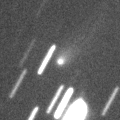
|
It brightened up to 14.5 mag in December (Dec. 22, Alan Hale). Now it is 17.4 mag (Mar. 13, E. Jehin, et al.). The orbit is extremely hyperbolic with e=3.35. It is the first interstellar comet in history. It will be fading after this, and will be fainter than 18 mag in April. In the Southern Hemisphere, it is observable in excellent condition. In the Northern Hemisphere, it will never be observable again.
Date(TT) R.A. (2000) Decl. Delta r Elong. m1 Best Time(A, h)
Mar. 28 12 45.56 -69 52.0 2.619 3.147 113 17.6 0:25 ( 0, 55)
Apr. 4 12 40.61 -70 5.7 2.705 3.264 115 17.8 23:47 ( 0, 55)
|

|
Now it is 17.4 mag (Mar. 18, Toshihiko Ikemura, Hirohisa Sato). It will brighten up to 13 mag in 2022. In 2020, it is observable at 17.5 mag in good condition in spring. It locates somewhat low in the Southern Hemisphere.
Date(TT) R.A. (2000) Decl. Delta r Elong. m1 Best Time(A, h)
Mar. 28 10 15.17 22 7.4 3.687 4.489 139 17.6 21:50 (180, 33)
Apr. 4 10 12.43 22 8.3 3.747 4.476 131 17.6 21:20 (180, 33)
|

|
It brightened up to 13 mag from autumn to winter in 2018. Now it is fading. It has already faded down to 17.0 mag (Mar. 17, Toshihiko Ikemura, Hirohisa Sato). It will be fainter than 18 mag in April.
Date(TT) R.A. (2000) Decl. Delta r Elong. m1 Best Time(A, h)
Mar. 28 8 48.27 10 30.6 2.620 3.282 123 17.6 20:24 (180, 45)
Apr. 4 8 49.06 10 46.0 2.736 3.313 117 17.8 19:57 (180, 44)
|

|
It brightened up to 15.5 mag from 2017 to 2018. Now it is fading. It has already faded down to 17.7 mag (Mar. 20, Toshihiko Ikemura, Hirohisa Sato). It will be fainter than 18 mag in late April.
Date(TT) R.A. (2000) Decl. Delta r Elong. m1 Best Time(A, h)
Mar. 28 12 37.48 10 25.6 9.867 10.840 166 17.9 0:16 (180, 45)
Apr. 4 12 36.01 10 42.1 9.897 10.858 163 17.9 23:43 (180, 44)
|
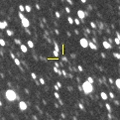
|
Now it is 17.8 mag (Oct. 9, Toshihiko Ikemura, Hirohisa Sato). It stays observable at 18 mag for a long time from 2019 to 2021.
Date(TT) R.A. (2000) Decl. Delta r Elong. m1 Best Time(A, h)
Mar. 28 19 16.61 -14 29.6 7.808 7.679 78 17.9 4:45 (243, 54)
Apr. 4 19 17.57 -14 48.0 7.691 7.679 85 17.9 4:51 (233, 60)
|

|
It will pass the perihelion in 2021, and it is predicted to be observable at 17-18 mag from 2020 to 2022. However, it has not been observed at all since 2015. It was not detected, fainter than 20.5 mag, in 2017 May (Werner Hasubick).
Date(TT) R.A. (2000) Decl. Delta r Elong. m1 Best Time(A, h)
Mar. 28 20 20.95 -23 0.1 6.507 6.159 65 18.0 4:45 (267, 46)
Apr. 4 20 24.99 -22 46.9 6.391 6.144 71 17.9 4:51 (262, 52)
|
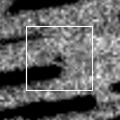
|
It is observable at 17.5 mag in good condition in spring. It has not been observed since 2019 January.
Date(TT) R.A. (2000) Decl. Delta r Elong. m1 Best Time(A, h)
Mar. 28 18 7.75 -17 35.6 2.075 2.389 95 17.9 4:45 (222, 68)
Apr. 4 18 13.41 -17 28.2 2.017 2.418 101 18.0 4:51 (205, 71)
|

|
It passed the perihelion on Jan . 17. Now it is fading very rapidly. But it is observable in excellent condition.
Date(TT) R.A. (2000) Decl. Delta r Elong. m1 Best Time(A, h)
Mar. 28 7 10.92 11 30.4 1.196 1.686 100 22.7 19:23 (168, 43)
Apr. 4 7 21.61 12 23.0 1.385 1.787 95 23.2 19:14 (166, 42)
|
|
![]()
 C/2018 N2 ( ASASSN )
C/2018 N2 ( ASASSN ) C/2019 U6 ( Lemmon )
C/2019 U6 ( Lemmon ) C/2020 A2 ( Iwamoto )
C/2020 A2 ( Iwamoto ) 29P/Schwassmann-Wachmann 1
29P/Schwassmann-Wachmann 1 88P/Howell
88P/Howell 246P/NEAT
246P/NEAT C/2019 N1 ( ATLAS )
C/2019 N1 ( ATLAS ) C/2018 F4 ( PanSTARRS )
C/2018 F4 ( PanSTARRS ) C/2019 F1 ( ATLAS-Africano )
C/2019 F1 ( ATLAS-Africano ) 390P/2019 U1 ( Gibbs )
390P/2019 U1 ( Gibbs ) C/2017 K2 ( PanSTARRS )
C/2017 K2 ( PanSTARRS ) C/2019 K7 ( Smith )
C/2019 K7 ( Smith ) C/2018 A6 ( Gibbs )
C/2018 A6 ( Gibbs ) C/2016 M1 ( PanSTARRS )
C/2016 M1 ( PanSTARRS ) C/2019 K1 ( ATLAS )
C/2019 K1 ( ATLAS ) C/2018 U1 ( Lemmon )
C/2018 U1 ( Lemmon ) 124P/Mrkos
124P/Mrkos C/2019 C1 ( ATLAS )
C/2019 C1 ( ATLAS ) C/2017 M4 ( ATLAS )
C/2017 M4 ( ATLAS ) P/2019 Y2 ( Fuls )
P/2019 Y2 ( Fuls ) 112P/Urata-Niijima
112P/Urata-Niijima C/2017 U7 ( PanSTARRS )
C/2017 U7 ( PanSTARRS ) C/2018 W2 ( Africano )
C/2018 W2 ( Africano ) 114P/Wiseman-Skiff
114P/Wiseman-Skiff 87P/Bus
87P/Bus 249P/LINEAR
249P/LINEAR C/2019 T4 ( ATLAS )
C/2019 T4 ( ATLAS ) (944) Hidalgo
(944) Hidalgo 257P/Catalina
257P/Catalina C/2010 U3 ( Boattini )
C/2010 U3 ( Boattini ) 115P/Maury
115P/Maury C/2017 Y2 ( PanSTARRS )
C/2017 Y2 ( PanSTARRS ) 2I/2019 Q4 ( Borisov )
2I/2019 Q4 ( Borisov ) 117P/Helin-Roman-Alu 1
117P/Helin-Roman-Alu 1 78P/Gehrels 2
78P/Gehrels 2 C/2014 B1 ( Schwartz )
C/2014 B1 ( Schwartz ) C/2017 K5 ( PanSTARRS )
C/2017 K5 ( PanSTARRS ) C/2014 F3 ( Sheppard-Trujillo )
C/2014 F3 ( Sheppard-Trujillo ) 175P/Hergenrother
175P/Hergenrother 321P/SOHO
321P/SOHO![]()




































